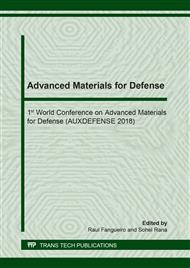[1]
Santos G, Oliveira C, Barros A, Ferreira P. New methods for comfort and ergonomics evaluation of smart acclimatisation textile systems. Protective and smart textiles, comfort and well-being. Lodz University of Technology, Poland, 2015, pp.78-86.
Google Scholar
[2]
Bendkowska W., Kłonowska M., Kopias K., Bogdan A.; Thermal Manikin Evaluation of PCM Cooling Vests. FIBRES & TEXTILES in Eastern Europe 2010, Vol. 18, No. 1 (78) pp.70-74.
Google Scholar
[3]
Ibáñez-Puy, M., Sacristán-Fernández, J.A., Martín-Gómez, C. Construction of an Active Façade Envelope with Peltier Cells.
DOI: 10.1016/j.egypro.2014.11.946
Google Scholar
[4]
Jennifer Woodson , Spacer Fabrics Utilized in Active Wear, TT553-Formation and Structure of Woven and Knitted Fabrics , Spring (2009).
Google Scholar
[5]
How to improve comfort and range of utility of combat uniforms for cold environments, 24-Sep-2012 | 435-EN, Hohenstein.
Google Scholar
[6]
Richard A Scott, Textiles in Defence, Colchester, Essex CO2 7SS, UK, (1997).
DOI: 10.1533/9781855738966.425
Google Scholar
[7]
Małgorzata Matusiak, Investigation of the Thermal Insulation Properties of Multilayer Textiles, Institute of Textile Architecture, FIBRES & TEXTILES in Eastern Europe January/December 2006, Vol. 14, No. 5 (59).
Google Scholar
[8]
GEORGE HAVENITH, Heat Balance When Wearing Protective Clothing, 1999 British Occupational Hygiene Society. Published by Elsevier Science Ltd. All rights reserved.
DOI: 10.1016/s0003-4878(99)00051-4
Google Scholar
[9]
Joanne Yip∗, Sun-Pui Ng, Study of three-dimensional spacer fabrics: Physical and mechanical properties, journal of materials processing technology 2 0 6 ( 2 0 0 8 ) 359–364.
DOI: 10.1016/j.jmatprotec.2007.12.073
Google Scholar
[10]
Buller, M.J., et al, Thermal-Work Strain during Marine rifle squad operations in Afghanistan (March 2010), 2011, USARIEM Technical Report T11-02, US Army Research Institute of Environmental Medicine, Massachussetts.
Google Scholar
[11]
Space Medicine, The Safe&Cool Technology by Gene Ostrovsky on Mar 6, (2006).
Google Scholar
[12]
Maj, J. AECTP 200 – Environmental Conditions (Edition 3). NATO Standardization Agency (NSA). (2006).
Google Scholar
[13]
Richard A Scott, Textiles for Protection, The Textile Institute, Woodhead Publishing ISBN 978-1-85573-921-5, (2010).
Google Scholar
[14]
NP EN 343, Protective clothing – Clothing for protection against foul weather, (2005).
DOI: 10.3403/01358352u
Google Scholar
[15]
ISO 11092:2014 – Textiles - Physiological effects - Measurement of thermal and water-vapour resistance under steady-state conditions. International Organization for Standardization. (2014).
DOI: 10.3403/30296435
Google Scholar
[16]
ISO 9237:1195 – Textiles -- Determination of the permeability of fabrics to air. International Organization for Standardization. (1995).
Google Scholar
[17]
EN 20811:1992 – Textiles. Determination of resistance to water penetration. Hydrostatic pressure test. (1992).
Google Scholar
[18]
ISO 15831:2004 – Clothing - Physiological effects - Measurement of thermal insulation by means of a thermal manikin. International Organization for Standardization. (2004).
DOI: 10.3403/03001973
Google Scholar
[19]
ASTM F 2370-16 - Standard Test Method for Measuring the Evaporative Resistance of Clothing Using a Sweating Manikin. American Society for Testing and Materials. (2016).
DOI: 10.1520/f2370-15
Google Scholar
[20]
ASTM F 2371-16 - Standard Test Method for Measuring the Heat Removal Rate of Personal Cooling Systems Using a Sweating Heated Manikin. (2016).
DOI: 10.1520/f2371-16
Google Scholar
[21]
Milenkovic L., Skundric P., Sokolovic R., Nikolic T.; Comfort Properties of Defense Protective Clothings; Working and Living Environmental Protection, Vol. 1, No 4, 1999, pp.101-106; Facta Universitatis; December (1999).
Google Scholar
[22]
Goldman R., Kampmann B.; Biomedical Effects of Military Clothing and Equipment Systems; Handbook on Clothing, 2nd Edition, (2007).
Google Scholar
[23]
NATO International Staff – Defence Support Division; ACCP-1 - Allied Combat Clothing Publication 1: Heat Transfer and Physiological Evaluation of Clothing (Edition 2), (1992).
Google Scholar
[24]
Wilusz, E., Military Textiles, ISBN 978-1-84569-206-3, First Edition, (2008).
Google Scholar
[25]
NP EN 342, Protective clothing – Ensembles and clothing for protection against cold, (2004).
Google Scholar
[26]
http://www.safeeurope.co.uk/media/6690/steve%20hunter %20presentation.pdf.
Google Scholar
[27]
http://www.ventilationvest.com/entrak/military/product-information/product-details.html.
Google Scholar
[28]
http://www.icevests.com.au/ultra-sport-evaporative-cooling-vest-small-chest-8691cm-p-125.html.
Google Scholar
[29]
http://www.rev-it.co.uk/item4500.htm.
Google Scholar
[30]
www.veskimo.com.
Google Scholar
[31]
http://www.draeger.ca/media/10/02/44/10024408/kuehlweste_pi_9041406_en.pdf.
Google Scholar
[32]
www.steelevest.com, www.stacoolvest.com, www.heatreliefdepot.com, www.polarproducts.com.
DOI: 10.1089/glre.2016.201011
Google Scholar
[33]
http://www.dhamainnovations.com.
Google Scholar
[34]
http://www.indiamart.com/dhama-innovations/products.html.
Google Scholar
[35]
Ertekin, G., et al, (2011), Heat, air and water vapour transfer properties of circular knitted spacer fabrics, Tekstil ve Konfeksíon.
Google Scholar


